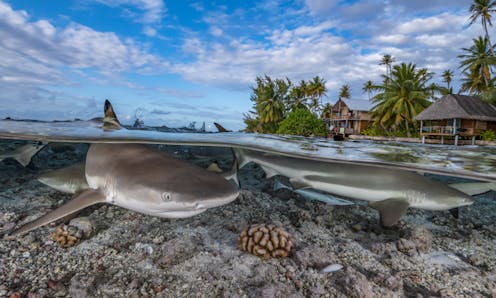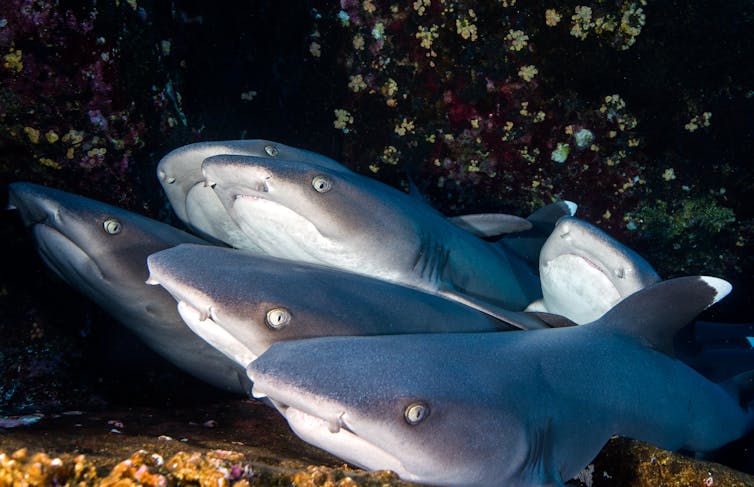
Shark populations have been declining for years, largely due to overfishing. And for years, the solutions offered by researchers have included increasing the number, size and effectiveness of marine protected areas (MPA) and improving the global management of sharks and stingrays in fisheries that catch them.
However, the large expanse of the ocean makes it hard to properly enforce protections in these MPAs, making this a global challenge. A solution to this issue lies in the use of international treaties like the Convention on International Trade in Endangered Species of Wild Fauna and Flora (CITES), wherein 184 member countries propose ways to ensure that species are not threatened due to international trade.
At the recent CITES Conference of the Parties (COP19) held in Panama City in November 2022, I witnessed the discussions that went into four proposals to include 104 shark and ray species in the CITES Appendix II. The acceptance of these four proposals, which included 54 requiem sharks, 37 guitarfishes, six hammerheads and seven river rays, would restrict their trade to sustainable and legal avenues.
This listing would impact global fisheries and trade, especially considering that the requiem sharks make up over half of the global annual reported catch of sharks and rays. Guitarfishes are, meanwhile, heavily traded throughout Africa and southern Asia. All four shark and ray proposals passed and the species were added to the list. But how good is this news really?
Why are sharks and rays declining today?
On the surface, these new protections for sharks and rays are a step in the right direction. But, being listed on CITES means the species’ population was in steep decline, driven by humans trading these species at unsustainable levels.
This unsustainable trade is due to improper management, or in some cases — no management of the catch and landing of sharks and rays in fisheries.

In our newly published paper, we revealed that requiem sharks only have half of the ideal management in place and in another paper show that guitarfish have just 45 per cent of ideal management in fisheries across 30 countries and four Regional Fisheries Management Organizations.
On assessing their fisheries management, we found that most countries have a central management body in place, engage with international treaties (like CITES) and manage illegal, unreported and unregulated fishing. This shows they have the capacity and infrastructure to ideally manage sharks and rays.
However, this was not usually the case. We found most countries have little understanding of the population status of species in their waters and few, if any, landing limits — number of individuals or total tonnes allowed to be caught — were imposed for sharks and rays.
We did find that landing limits were more likely to exist for species already listed on CITES Appendix II — like the Oceanic Whitetip and Silky Sharks. Therefore, the inclusion of an additional 104 species will hopefully improve management of sharks and rays in fisheries globally.
There are big differences in how well sharks and rays are managed globally. In wide-ranging species, like many requiem sharks, they are subject to a patchwork of management. For example, the Blacktip Reef Shark is well-managed in Australia, but less so elsewhere in its range.
While guitarfish are found throughout the tropics, the distribution of their various individual species vary across waters of different countries. One species is found in Tanzania and Madagascar, while another can be found in Malaysia and Indonesia. Another species is found in the waters surrounding Taiwan. This varied distribution means that each species’ global status is directly related to how well these countries manage their catch.
According to the International Union for Conservation of Nature’s Red List of Threatened Species, over 77 per cent of guitarfish are threatened with extinction, meaning current management is not working. What’s worse? There is no data regarding the volume and species of guitarfish that are traded internationally.
We need fisheries legislation that requires species-specific reporting of catch and trade in these species to better understand the population status and changes in abundance of these species.
How does Canada fit in?
Canada is blessed with vast forests, lakes and oceans. But it failed to protect its biodiversity as planned at the United Nations Convention on Biological Diversity (CBD) in Japan in 2010, or the Aichi Biodiversity Targets.
In particular, Target 11, which states 10 per cent of coastal and marine areas and 17 per cent of terrestrial and inland waters should be protected by 2020. Despite these targets not being met, more ambitious goals have been set at the most recent CBD meeting in Montréal, including protecting 30 per cent of the world’s land and ocean by 2030.
Canada voted against protecting guitarfishes at CITES COP19. There are no guitarfishes that live in Canadian waters, nor is there any evidence of import. Therefore, this vote would not affect any catch, landings or trade for Canada.
All votes regarding requiem sharks were done by secret ballot, so Canada’s vote can only be speculated on. However, Canada spoke in support of the removal of ‘look-alike’ species, which includes the only requiem shark found in Canadian waters — the near-threatened Blue Shark.
The discussions concluded with the final vote to include all requiem shark species on Appendix II, which was accepted with 75 per cent support including the European Union and its Member States and the USA who declared their votes publicly.
What does this all mean?
Canada should be transparent about the reasons environmental policies like the Aichi targets or the CITES voting are or are not put in place. Citizens have a right to know how their government is voting on international policies (like the protection of requiem sharks), and the reasons behind those decisions.
On a global scale, fisheries need to be managed as per the most susceptible species nations interact with. The excuse that sharks and rays are “unavoidable bycatch” has led to severe declines in their populations in all environments.
In the open ocean, shark and ray populations have declined by 71 per cent in the last half century. Sharks and rays have been so overfished on coral reefs that almost two-thirds are now threatened with extinction.
There is hope still.
New research shows that implementing science-based effective limits on fishing can improve the status of shark populations. However, it takes time for these long-lived animals to recover, which is why changes need to be made immediately.
Improved fisheries management is essential to ensure long-term sustainability for sharks and rays as well as the associated fisheries as food and income sources. Managing fisheries —the main threat for sharks and rays — is the only way to prevent them from needing international protection like CITES in the future.
Samantha Sherman received funding from the Shark Conservation Fund. She is a member of the IUCN SSC Shark Specialist Group
This article was originally published on The Conversation. Read the original article.







